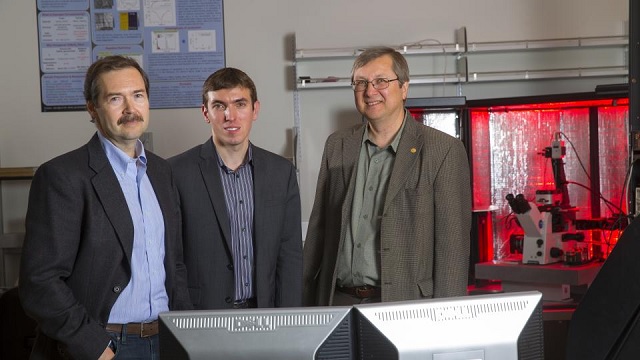 Left to right, University of Nebraska-Lincoln scientists Alexei Gruverman, Alexander Sinitskii and Evgeny Tsymbal (Craig Chandler | University Communications)
Left to right, University of Nebraska-Lincoln scientists Alexei Gruverman, Alexander Sinitskii and Evgeny Tsymbal (Craig Chandler | University Communications)
A team researchers from UNL have enhanced the characteristics of a component used in the next-generation of high-speed RAM, using a common household chemical and a Nobel Prize-winning material.
The application of chemistry and physics at the atomic scale level has significantly contributed to the advancements in random access memory (RAM) over the last decade.
The team from UNL demonstrated improvements in the performance of a memory structure known as a ferroelectric tunnel junction. This junction consists of a ferroelectric layer, which is 100,000 times thinner than a sheet paper, through which electrons can pass by.
This ferroelectric layer is situated between two electrodes which reverse the polarisation direction (the orientation of positive and negative charges indicating "0" and "1" in binary computing) by applying an electric field.
The research team at UNL have become the first to develop a ferroelectric junction using graphene electrodes. Graphene's high conductivity makes it ideal for use in small-scale electronics. The team introduced ammonia between the graphene and the ferroelectric layer.
The polarity of the junction determines its resistance to tunnelling current. The researchers observed that the small-scale electronic ‘on’ and ‘off’ conditions of the junction were increased using the graphene-ammonia combination, resulting in the improved reliability of RAM devices.
This graphene-ammonia combination has never been used previously commercialised technologies or in emergent ferroelectric technologies. Ferroelectric materials are less non-volatile which allows them to retain stored information even in the absence of a power source.
The infinitesimally small space between the positive and negative charges within the junction makes the maintenance of the polarisation difficult. In addition, this combination of materials may have applications in enhancing the polarisation stability of the junction.
In all memory devices, there is a gradual relaxation, or decrease, of this polarization. The thinner the ferroelectric layer is, the more difficult it is to keep these polarization charges separate, as there is a stronger driving force in the material that tries to get rid of it.
Alexei Gruverman, Charles Bessey Professor of Physics
The findings of this study were published in the Nature Communications journal.